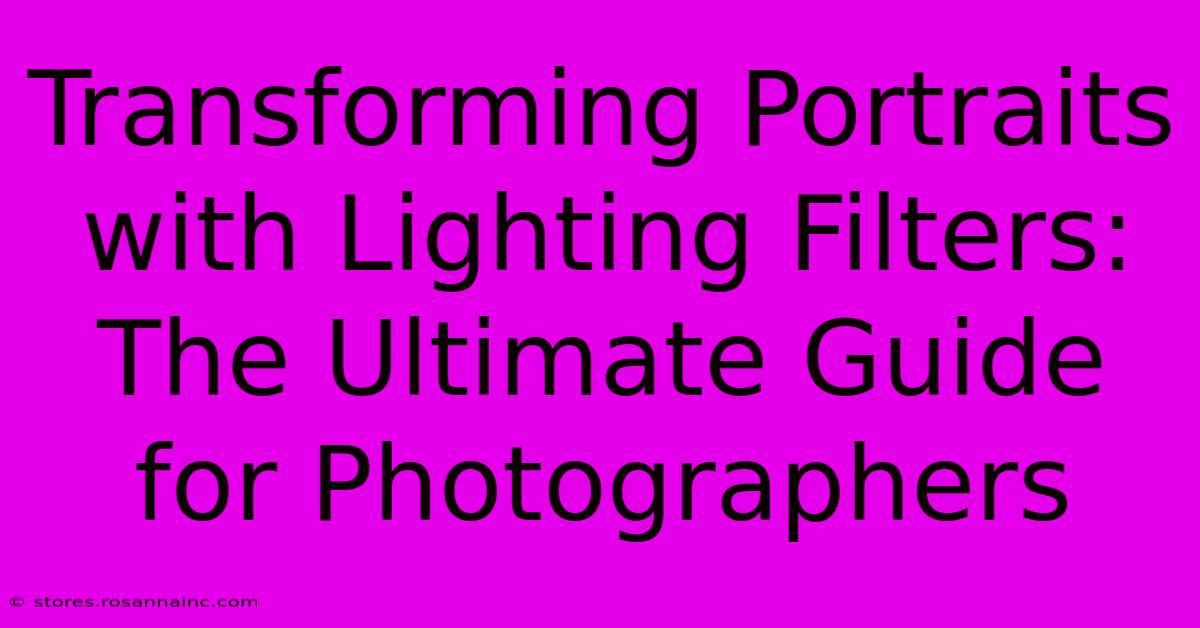Transforming Portraits With Lighting Filters: The Ultimate Guide For Photographers

Table of Contents
Transforming Portraits with Lighting Filters: The Ultimate Guide for Photographers
Lighting is everything in portrait photography. It shapes the mood, defines the subject, and can make or break a shot. While mastering natural light is crucial, lighting filters offer photographers unparalleled control and creative possibilities, transforming ordinary portraits into extraordinary works of art. This ultimate guide will explore the diverse world of lighting filters, revealing how to use them to enhance your portrait photography.
Understanding the Power of Lighting Filters
Lighting filters aren't just about changing the color of your light; they fundamentally alter its quality and direction. They can:
- Soften harsh light: Diffusing filters reduce shadows and create a softer, more flattering look, ideal for portraits.
- Control contrast: Graduated filters allow you to selectively brighten or darken portions of the scene, balancing highlights and shadows for a more even exposure.
- Add color and mood: Colored filters dramatically change the overall tone and feeling of your image, from warm and inviting to cool and dramatic.
- Create special effects: Certain filters, such as star filters or diffusion gels, can add unique artistic elements, adding sparkle or a dreamy quality.
Types of Lighting Filters for Portraits
The world of lighting filters is vast. Here are some of the most popular types used in portrait photography:
1. Diffusion Filters:
What they do: These filters soften harsh light, reducing contrast and creating a more even, flattering illumination. They're especially useful for outdoor portraits on sunny days or when working with harsh studio lighting.
Types: Soft white diffusion, silk, and gridded diffusion filters offer varying degrees of softening.
Best use cases: Outdoor portraits, minimizing harsh shadows, creating a dreamy effect.
2. Graduated Neutral Density (GND) Filters:
What they do: These filters darken a portion of the image, typically the sky, allowing you to balance the exposure between a bright sky and a darker foreground.
Types: Hard-edged GND filters offer a sharp transition, while soft-edged GND filters provide a smoother blend. Reverse GND filters darken the bottom of the image.
Best use cases: Balancing exposure in high-contrast scenes, maintaining detail in both bright skies and shadowed foregrounds.
3. Colored Gels:
What they do: These filters add color to your light source, drastically changing the mood and tone of your portrait.
Types: A wide variety of colors are available, from warm oranges and yellows to cool blues and greens.
Best use cases: Creating specific moods (e.g., warm and romantic, cool and moody), adding creative flair.
4. Polarizing Filters:
What they do: These filters reduce glare and reflections, enhancing color saturation and contrast. They are particularly useful for reducing reflections on skin and enhancing the vibrancy of eyes.
Best use cases: Reducing glare from skin, enhancing eye color, increasing saturation and contrast.
Mastering the Art of Lighting Filter Application
Using lighting filters effectively involves understanding your light source and the desired effect. Here are some tips:
- Experiment: The best way to learn is to experiment with different filters and see how they affect your images.
- Start simple: Begin with basic diffusion filters before moving on to more complex options like GND filters or colored gels.
- Consider the background: The background can significantly influence the overall effect of your lighting filters.
- Shoot in RAW: Shooting in RAW format allows you more flexibility in post-processing to fine-tune your exposure and color balance.
- Control your light source: Whether you are using natural light or studio strobes, understanding how to control the direction and intensity of your light is essential when using filters.
Beyond the Basics: Advanced Techniques
- Combining filters: Experiment with stacking multiple filters to achieve more complex effects. For example, combining a diffusion filter with a colored gel can create a uniquely soft and colored light.
- Filter holders: Investing in a filter holder system will make using and switching between filters much easier and more efficient, especially when using multiple filters.
- Light painting with gels: Use colored gels on your speed lights or flash to dramatically change the mood in your night portraits.
Conclusion: Unleash Your Creative Potential
Lighting filters are invaluable tools for photographers looking to elevate their portrait photography. By understanding their capabilities and mastering their application, you can transform ordinary portraits into stunning works of art, capturing captivating expressions and moods that truly resonate. Embrace the creative possibilities offered by lighting filters and take your portrait photography to the next level.

Thank you for visiting our website wich cover about Transforming Portraits With Lighting Filters: The Ultimate Guide For Photographers. We hope the information provided has been useful to you. Feel free to contact us if you have any questions or need further assistance. See you next time and dont miss to bookmark.
Featured Posts
-
Tired Of Cleaning Heres Your Ticket To A Clean Home Paradise
Feb 04, 2025
-
Prop Up Your Portraits Creative Expressions Through Accessories
Feb 04, 2025
-
Unveiling The Hidden Meanings Mothers Day Plants That Symbolize Her Love
Feb 04, 2025
-
Breathe Easy With Palm Purification Unleash The Air Cleansing Wonders Of Palm Fronds
Feb 04, 2025
-
Masterpieces Revealed From Ancient Parchments To Modern Marvels
Feb 04, 2025
